|
Troopers Hill has a fascinating history that has shaped its appearance today. The most obvious feature is the Grade 2 listed chimney at the top of the hill which may date from as early as the eighteenth century. The Friends of Troopers Hill have incorporated the chimney, with its characteristic lean to the west, into their logo. A brief summary of what we have learnt is given below. You might also like to look at our Old Photographs and Memories of Troopers Hill pages.
extract1.jpg) Harris Hill Harris Hill
The area that is now known as Troopers Hill is on the edge of Kingswood Forest or Chase overlooking the river Avon. As can be seen from the extract shown on the right, the hill was named as 'Harris hill' on a map of Kingswood dated 1610. A larger section can be seen here. A later map of 1672 also shows 'Harris hill lands'. Many thanks to Bristol Record Office for allowing us to reproduce this extract of the colour map and also to Dundridge Park Group for finding it for us.
Civil War
Local tradition has it that the Parliamentary army, under the command of Sir Thomas Fairfax, camped on Troopers Hill prior the siege of Bristol in 1645. It has also been suggested that the ditch between the hill and the allotments was dug at this time as a defensive earthworks. It is known that the army approached Bristol via Keynsham and Hanham and it is possible therefore that Troopers Hill, with its views of the city, was used while the Parliamentary army was headquartered at Hanham, but we have found no firm evidence of it.
Copper Smelting
Crews Hole became a completely different place in the eighteenth century when the copper smelting industry was established in the area. Copper ore was brought by boat, mainly from Cornwall and north Devon and coal was sourced locally. The copper produced was mostly used with calamine (zinc ore) from the Mendips in the manufacture of brass at Baptist Mills and other sites in Bristol. Many of the brass products were exported to Africa to be bartered for slaves as part of the 'triangular trade'.
Abraham Elton established a copper smelting works at Conham in about 1698 and in around 1710 a copper smelting works was established by the Bristol Brass and Wire Company on land between the River Avon and where the Bull Inn now stands. This works became known as 'the Cupolas' and were the main industry in the vicinity of the hill.
From about 1750 the Brass Company started casting the waste copper slag into moulds to produce black building blocks. The best example of the use of these 'Bristol Black' blocks was in the building of the Black Castle at Arnos Vale but they can also be seen in many of the walls around the area. There is a group on flikr dedicated to collecting photographs of 'Bristol Black'. In around 1780 the Bristol Brass and Wire Company moved its copper smelting operations to Warmley having purchased the works of their rival William Champion and by about 1790 the Crews Hole site was abandoned.
More about the Copper Smelting and Brass industries can be found on the Living Easton Brass and Copper Works History web pages. The local expert on the industry is Joan Day who gave a talk to Friends of Troopers Hill in July 2004 and wrote 'Bristol Brass: The History of the Industry' from which much of this information and the photograph below is taken.
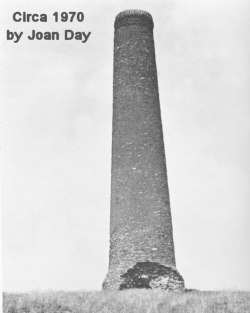 Troopers Hill Chimney Troopers Hill Chimney
The 1790s did not mark the end of copper smelting in Crews Hole; the site was leased to the Elton & Tyndall copper company until about 1796 and Matthews & Arnold had a brass and spelter (zinc) works in Crews Hole in the 1820s. So far we have no records of the use of the site between these dates but it could also have been used for lead smelting.
A map dated around 1803 was shown to the Friends of Troopers by the late John Cornwell, who ran the Bristol Coalmining Archives and was very enthusiastic about the industrial history of the area. This showed the 'Old Brass Works' where the cupolas were sited but also shows a separate 'Copper Works' adjacent to Troopers Hill. This works is located exactly where the flue from Troopers Hill chimney came down to the riverside. There seems to be no reason to have built the works on this site, which was set back from the river, if it was not to benefit from using the hill. Since the hill and the riverside site were both owned by the Brass Company it seems very likely that the chimney was built to serve this new Copper Works, probably in the 1790s. It is certain that the chimney was built before 1826, since it is shown in a drawing from this date of the view from Arnos Court commissioned by GW Braikenridge. By the end of the 1800s the chimney was being used by Stone & Tinson who had a large works on the site of the copper smelter. It seems that they continued to use the chimney until about the time of the First World War. As described below Butlers took over the Stone & Tinson site in 1924 after it had closed but by then the chimney was disused so it was never used by Butlers.
Heaps of Dross
Writing in the 1830s Elizabeth Emra (see our Memories page) described "the barren and quarried hill, with its yellow spots of gorse and broom, and its purple shade of heath, raising itself above the dark heaps of dross". The dictionary definition of dross is 'The scum thrown off from metals in smelting' and refers to the the slag that was left from the copper and lead smelting in the valley.
Recently we have received some information about another short lived industry in Crews Hole based on these heaps of dross. Nigel emailed us from Cheshire to say that he had found a reference to James Michell, responsible for copper mining at Alderley Edge in Cheshire in the 1860s, being declared bankrupt in 1856. His address then was given as Crews Hole, St George and Westbury-upon-Trym and he is described as a lead smelter.
Nigel has now found a
newspaper article in the Bristol Gazette for 6 November 1856 which explains Michell's role in Bristol. Nigel writes, "Michell went to Crews Hole in 1853 to reprocess the slag left
by the earlier working, said to be 130 years old. He probably brought with
him knowledge from his lead smelting experiences in Spain and Derbyshire and
possibly had made contact with the chemist William Henderson at this time.
Henderson developed the processing of copper ores with acid to extract the
metal without having to roast it at high temperatures and, possibly, this is
what Michell was going to do. Either way, it didn't work because the 'good'
slag was buried under more recent material and after 3 years (June 1853 to
August 1856) Michell declared himself bankrupt."
It seems that after the failure of his business venture in Crews Hole James Michell continued to be involved mining in Cheshire while still living in Bristol. Sadly this led to his death in 1862. The Bristol Gazette of 4 December that year reported 'a shocking accident occurred on Thursday morning last to Mr Michell, of the Hermitage, Westbury on Trym, which, we regret to add terminated fatally'. It reports that his foot slipped as he turned round to talk to his agent while ascending the pit and he fell over 30 feet to the bottom.
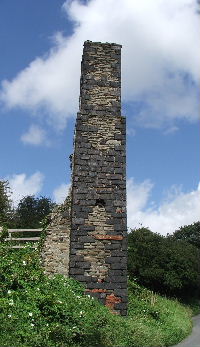 Coal Mining Coal Mining
So, while some copper and lead smelting continued in Crews Hole during the early years of the nineteenth century it seems to have been on a much smaller scale than in the eighteenth century. On Troopers Hill itself there was some quarrying of pennant sandstone during this period, but the most significant development was the opening of Troopers Hill Pit.
The chimney or stack that still stands at the junction of Troopers Hill Road and Crews Hole Road is all that remains of this colliery. Originally the chimney was at the corner of the engine house and parts of the walls of that building can still be seen. The corners of the stack are formed with black copper slag blocks. This structure is also Grade II listed. A Desk Study into the history of this chimney was carried out by Bristol & Region Archaeological Services for Bristol Parks in 2008. The mine shaft was behind the engine house on Troopers Hill in an area now covered in bramble; it is assumed that it was filled in after the colliery closed. The colliery, which was also known as Crews Hole Pit, was mining coal from the early 1800s and although the exact closure date is not known it was before 1845.
|
|
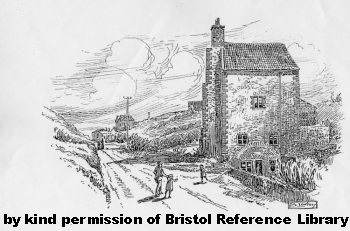 A second mine shaft and engine house was situated further up Troopers Hill Road and is shown in this drawing by Samuel Loxton from about 1914 (click on the drawing for a larger version). Both engine houses would have looked similar and the two shafts would have been linked below ground with one acting as the updraft ad one as the downdraft to ensure the mine was kept ventilated. In his book 'The Bristol Coalfield' John Cornwell refers to the Loxton drawing and says: 'A notable feature of the engine house is a large archway set in the side of the structure for installing and changing the cylinder of the engine, which is a feature of the early 19th century'.
Our thanks to Bristol Reference Library for their permission to reproduce the Loxton drawing. A second mine shaft and engine house was situated further up Troopers Hill Road and is shown in this drawing by Samuel Loxton from about 1914 (click on the drawing for a larger version). Both engine houses would have looked similar and the two shafts would have been linked below ground with one acting as the updraft ad one as the downdraft to ensure the mine was kept ventilated. In his book 'The Bristol Coalfield' John Cornwell refers to the Loxton drawing and says: 'A notable feature of the engine house is a large archway set in the side of the structure for installing and changing the cylinder of the engine, which is a feature of the early 19th century'.
Our thanks to Bristol Reference Library for their permission to reproduce the Loxton drawing.
There was also coalmining on Troopers Hill prior to the 1800s. Several coal seams outcrop in the area and it is likely that this would have been mined on a small scale from the 1600s or maybe earlier. On Troopers Hill there is evidence in the shape of the land of mine shafts that are likely to date from the 1700s. One of these is now showing signs of collapse as described here.
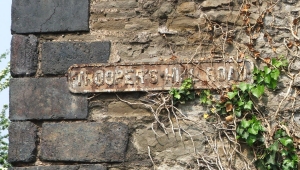 Troopers Hill - Origin of the Name Troopers Hill - Origin of the Name
1826 marks the first recorded use of the name 'Troopers Hill' when it was used on OS survey sheet of the Bristol area - you can see the map here (thanks to 'souterain' for posting the link on our Forum). Prior to this date the hill had been referred to as 'Harris Hill' or 'Truebody's Hill'.
In 1937, local historian William Sanigar wrote to the Ordnance Survey to ask about the name. In his letter he states that the Truebody family were owners and tenants of land in and around the neighbourhood for about a hundred years.
Troopers Hill and Truebody's Hill were both used through much of the nineteenth century, with Troopers Hill becoming the accepted name by the end of the century, possibly because of its use on the Ordnance Survey map. It remains in doubt as to whether the name came from the use of the hill by troopers in the civil war or at some other time; or whether it was simply a corruption of Truebody's Hill.
Fireclay Mine and Works
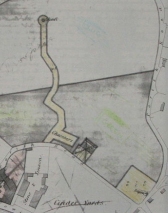 The plan shown here formed part of an 1886 lease of the land to the west of Stone and Tinson, together with mining rights under the hill, to the Bristol Fireclay Company. The lease is difficult to read but the wording was kindly typed for us by Margaret Watson from a copy given to us by the Council's property office, who have also given us permission to reproduce it. You can download a copy of the typed document here. In the lease the land is stated to have been formerly occupied by Mrs Elizabeth Braine and Ann Randall followed by Messrs Johnston Andrews & Company and then the Crown Clay Company. The plan shows the duct to the chimney, the cottages and the engine house as areas that shouldn't be undermined. The fireclay mines extended right under the hill and continued in use until they were abandoned in 1908. Two seams of clay were mined the five feet thick Dibb Clay and the deeper six feet thick Buff Clay. Two mine entrances were within the works area, while a third was in a quarry on the south-west side of the hill. Fireclay is often found below coal seems and it is possible that some of the works were opening up old coal mines.
The plan shown here formed part of an 1886 lease of the land to the west of Stone and Tinson, together with mining rights under the hill, to the Bristol Fireclay Company. The lease is difficult to read but the wording was kindly typed for us by Margaret Watson from a copy given to us by the Council's property office, who have also given us permission to reproduce it. You can download a copy of the typed document here. In the lease the land is stated to have been formerly occupied by Mrs Elizabeth Braine and Ann Randall followed by Messrs Johnston Andrews & Company and then the Crown Clay Company. The plan shows the duct to the chimney, the cottages and the engine house as areas that shouldn't be undermined. The fireclay mines extended right under the hill and continued in use until they were abandoned in 1908. Two seams of clay were mined the five feet thick Dibb Clay and the deeper six feet thick Buff Clay. Two mine entrances were within the works area, while a third was in a quarry on the south-west side of the hill. Fireclay is often found below coal seems and it is possible that some of the works were opening up old coal mines.
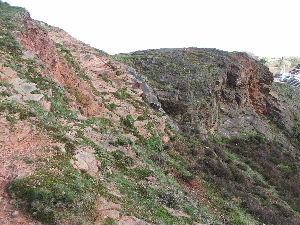 Pennant Sandstone Quarrying Pennant Sandstone Quarrying
The industry that had the most effect on the shape of Troopers Hill as we see it today was the quarrying of pennant sandstone for use in building.
The 1890 Ordnance Survey map shows a quarry in what is now known as 'the gully'. Comparison of this map with the second edition Ordnance Survey map of 1904 clearly shows that a lot of rock was removed between the dates of the surveys for these two editions. The shape of the hill in 1904 was much as it is now so quarrying must have ceased soon afterwards. The humps between the gully and Troopers Hill Road are tipped waste from this quarry. A quarry is also shown on the south-west of the hill on the 1890 map that has become an 'old quarry' by 1904. The 1890 map also shows an 'old quarry' adjacent to the colliery engine house at the Crews Hole end of Troopers Hill Road.
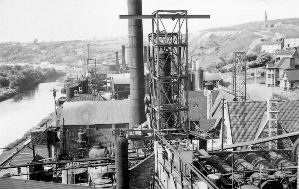 Tar Works Tar Works
1843 saw the start of a new industry adjacent to Troopers Hill that dominated the area until 1981. The Great Western Railway from Bristol to Paddington was built under the direction of I K Brunel between 1835 and 1841. While the railway was under construction in 1838 John Bethell patented creosote as a timber preservative and Brunel realised that its use would be a benefit to his new railway.
Brunel took out a licence with John Bethell for use of his patent. He also took technical advice from Bethell in the erection of a Tar Distillery on the site of the original copperworks at Crews Hole. The works were owned and financed by Roberts & Daines who also owned an Iron Works in Silverthorne Lane. It is not known whether they purchased the site when it was sold by the Brass Company in 1828 or obtained it later. William Butler was appointed as manager of the works from the start of operations. He had previously employed by Brunel on the Bristol and Exeter Railway so it seems likely that Brunel was responsible for his appointment. In 1863 a fire broke out that nearly destroyed the plant and Robert & Daines then sold the works to William Butler who operated the plant under the name of William Butler & Co Ltd.
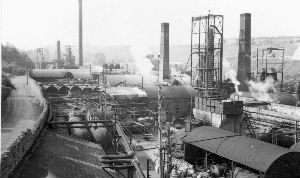 William Butler & Co Ltd became a very successful and innovative company. When the adjacent Conham Chemical Works closed in 1904 and Stone and Tinson's in 1924, both sites
were incorporated into the Butler Works together with the site occupied by the fireclay mine. Butlers then became the only industry in the area immediately adjacent Troopers Hill. In 1952 Butlers separated their tar distillation and other businesses with the formation of Bristol and West Tar Distillers, in which the Southwestern Gas Board took a 25% stake. Then in 1962 the Gas Board became sole owners of this company, and soon afterwards Butlers moved all their operations away from Crews Hole and Silverthorne Lane to a new base at the Rockingham Works at Avonmouth where they operated under the name of Butlers Chemicals Ltd. Below Troopers Hill the Gas Board continued to operate the tar works to treat the crude tar generated from the production of town gas. The introduction of North Sea Gas took away this source of tar, but tar was still being produced by the coke works linked to the steel industry in South Wales and so a means of getting rid of this waste product was still required.
On 1st April 1970 the ownership of Bristol and West Tar Distillers changed hands for the last time when it became owned by the British Steel Corporation (BSC). The contraction of the steel industry in the late 1970s reduced the need for tar distillation and so the Crews Hole works closed in 1981 as BSC reduced the number of tar plants that they operated. William Butler & Co Ltd became a very successful and innovative company. When the adjacent Conham Chemical Works closed in 1904 and Stone and Tinson's in 1924, both sites
were incorporated into the Butler Works together with the site occupied by the fireclay mine. Butlers then became the only industry in the area immediately adjacent Troopers Hill. In 1952 Butlers separated their tar distillation and other businesses with the formation of Bristol and West Tar Distillers, in which the Southwestern Gas Board took a 25% stake. Then in 1962 the Gas Board became sole owners of this company, and soon afterwards Butlers moved all their operations away from Crews Hole and Silverthorne Lane to a new base at the Rockingham Works at Avonmouth where they operated under the name of Butlers Chemicals Ltd. Below Troopers Hill the Gas Board continued to operate the tar works to treat the crude tar generated from the production of town gas. The introduction of North Sea Gas took away this source of tar, but tar was still being produced by the coke works linked to the steel industry in South Wales and so a means of getting rid of this waste product was still required.
On 1st April 1970 the ownership of Bristol and West Tar Distillers changed hands for the last time when it became owned by the British Steel Corporation (BSC). The contraction of the steel industry in the late 1970s reduced the need for tar distillation and so the Crews Hole works closed in 1981 as BSC reduced the number of tar plants that they operated.
The Tar Works and Troopers Hill in Photographs
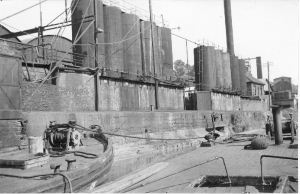 In 1953 a book was produced by the company giving details of its history over the previous 110 years. Friends of Troopers Hill were given a copy of this book, which was written by Dr T. Howard Butler, the founder's grandson, at their history exhibition in September 2005. Another excellent account of the history of the works is in paper written by Raymond Holland, who worked at the tar works for 20 years. Raymond gave a talk based on his paper to the St George History Group in September 2009. It has been published by the Society of Chemical Industry under the title 'A History of Tar Distillation at Crew's Hole, Bristol' and can be downloaded here. The photographs of the works on this page were taken in 1953 and belong to Raymond Holland who was kind enough to give us permission to use them. More of Raymond's photographs can be seen on our Old Photographs page, together with many other photos showing the Tar Works and Troopers Hill and the changes that have taken place since the works closed. In 1953 a book was produced by the company giving details of its history over the previous 110 years. Friends of Troopers Hill were given a copy of this book, which was written by Dr T. Howard Butler, the founder's grandson, at their history exhibition in September 2005. Another excellent account of the history of the works is in paper written by Raymond Holland, who worked at the tar works for 20 years. Raymond gave a talk based on his paper to the St George History Group in September 2009. It has been published by the Society of Chemical Industry under the title 'A History of Tar Distillation at Crew's Hole, Bristol' and can be downloaded here. The photographs of the works on this page were taken in 1953 and belong to Raymond Holland who was kind enough to give us permission to use them. More of Raymond's photographs can be seen on our Old Photographs page, together with many other photos showing the Tar Works and Troopers Hill and the changes that have taken place since the works closed.
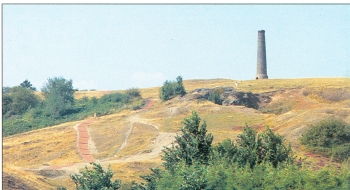 Recent History Recent History
Troopers Hill was purchased by Bristol City Council in 1956 for use as a public open space. The adjacent land between the hill and Lamb Hill was purchased in the same year, but this was for use as Malvern Road Tip. The hill was largely left to take care of itself and seems to have remained largely unchanged until the early 1990s. Following the closure of the Tar Works and St Annes Board Mills in the 1980s various plans were made to regenerate the area. Little came of these plans but in 1991 the Bristol Development Corporation installed fences around the site and constructed new paths (see Set G on our Old Photographs page). This was aimed at keeping motorcycles off the site and 'stopping Troopers Hill from wearing out'. Troopers Hill was declared as a Local Nature Reserve (LNR) on 22nd June 1995 (click for copy of public notice) in recognition of the wide range of wildlife present on the hill and its importance as a unique habitat in the Bristol area due to the presence of acidic soils. The start of the Wildspace! project in 2002 run by Sally Oldfield was the next significant event and led directly to the formation of Friends of Troopers Hill in December 2003. The hill's history since then is recorded elsewhere on this website.
More Information
There are three pdf documents that give more information on the history of the site that you can down load from the links below. The desk study into the lower chimney was commissioned by Bristol Parks and they and BARAS have both given us permission to post it here. It contains images of several old maps.
 History Timeline (54KB) History Timeline (54KB)
 A Brief History of Troopers Hill by Rob Acton-Campbell (469KB) A Brief History of Troopers Hill by Rob Acton-Campbell (469KB)
 Lower Chimney - Desk Study by Bristol & Region Archaeological Services Lower Chimney - Desk Study by Bristol & Region Archaeological Services
We have also produced a 'Hill History' leaflet, which summarises the information on this page.
 Download Site Leaflets Download Site Leaflets
If you are interested in the history of the area there are a number of local history groups listed on our Friends' Friends page.
The books used to put together this history are listed on our Hill Information page. Special thanks are due to the late John Cornwell; Joan Day and Raymond Holland.
|

extract1.jpg)
 Troopers Hill Chimney
Troopers Hill Chimney Tar Works
Tar Works William Butler & Co Ltd became a very successful and innovative company. When the adjacent Conham Chemical Works closed in 1904 and Stone and Tinson's in 1924, both sites
were incorporated into the Butler Works together with the site occupied by the fireclay mine. Butlers then became the only industry in the area immediately adjacent Troopers Hill. In 1952 Butlers separated their tar distillation and other businesses with the formation of Bristol and West Tar Distillers, in which the Southwestern Gas Board took a 25% stake. Then in 1962 the Gas Board became sole owners of this company, and soon afterwards Butlers moved all their operations away from Crews Hole and Silverthorne Lane to a new base at the Rockingham Works at Avonmouth where they operated under the name of Butlers Chemicals Ltd. Below Troopers Hill the Gas Board continued to operate the tar works to treat the crude tar generated from the production of town gas. The introduction of North Sea Gas took away this source of tar, but tar was still being produced by the coke works linked to the steel industry in South Wales and so a means of getting rid of this waste product was still required.
On 1st April 1970 the ownership of Bristol and West Tar Distillers changed hands for the last time when it became owned by the British Steel Corporation (BSC). The contraction of the steel industry in the late 1970s reduced the need for tar distillation and so the Crews Hole works closed in 1981 as BSC reduced the number of tar plants that they operated.
William Butler & Co Ltd became a very successful and innovative company. When the adjacent Conham Chemical Works closed in 1904 and Stone and Tinson's in 1924, both sites
were incorporated into the Butler Works together with the site occupied by the fireclay mine. Butlers then became the only industry in the area immediately adjacent Troopers Hill. In 1952 Butlers separated their tar distillation and other businesses with the formation of Bristol and West Tar Distillers, in which the Southwestern Gas Board took a 25% stake. Then in 1962 the Gas Board became sole owners of this company, and soon afterwards Butlers moved all their operations away from Crews Hole and Silverthorne Lane to a new base at the Rockingham Works at Avonmouth where they operated under the name of Butlers Chemicals Ltd. Below Troopers Hill the Gas Board continued to operate the tar works to treat the crude tar generated from the production of town gas. The introduction of North Sea Gas took away this source of tar, but tar was still being produced by the coke works linked to the steel industry in South Wales and so a means of getting rid of this waste product was still required.
On 1st April 1970 the ownership of Bristol and West Tar Distillers changed hands for the last time when it became owned by the British Steel Corporation (BSC). The contraction of the steel industry in the late 1970s reduced the need for tar distillation and so the Crews Hole works closed in 1981 as BSC reduced the number of tar plants that they operated.
 In 1953 a book was produced by the company giving details of its history over the previous 110 years. Friends of Troopers Hill were given a copy of this book, which was written by Dr T. Howard Butler, the founder's grandson, at their history exhibition in September 2005. Another excellent account of the history of the works is in paper written by Raymond Holland, who worked at the tar works for 20 years. Raymond gave a talk based on his paper to the St George History Group in September 2009. It has been published by the Society of Chemical Industry under the title 'A History of Tar Distillation at Crew's Hole, Bristol' and can be
In 1953 a book was produced by the company giving details of its history over the previous 110 years. Friends of Troopers Hill were given a copy of this book, which was written by Dr T. Howard Butler, the founder's grandson, at their history exhibition in September 2005. Another excellent account of the history of the works is in paper written by Raymond Holland, who worked at the tar works for 20 years. Raymond gave a talk based on his paper to the St George History Group in September 2009. It has been published by the Society of Chemical Industry under the title 'A History of Tar Distillation at Crew's Hole, Bristol' and can be  Recent History
Recent History